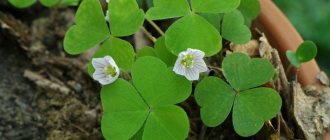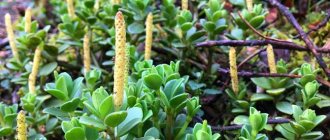general information
In fact, Decembrist or Schlumbergera is an epiphytic cactus native to the Brazilian tropics. It grows on other trees and stores moisture and nutrients abundantly in its segmented stems. Another name for Decembrist is zygocactus.
Unlike many epiphytes, Decembrist is not a parasite. He simply clings to trees and hides in their shade, but gets his own food. The average length of the shoots is about 40 cm, and they consist of flat, jagged or rounded links. New segments gradually grow from existing segments, and in winter buds appear at the tips of the stems.
Pink and red Decembrists are most often found, but breeders have already managed to develop a greater variety of shades. The flowers are multi-tiered, bizarre funnel-shaped, up to 8 cm and up to 30 petals each.
Photo: mandarin-shop.ru
Botanical description
Schlumbergera is an epiphytic cactus. It looks like a small herbaceous shrub with drooping, jointed stems, at the tips of which flowers bloom. Propagates well by shoots. It is widely used in breeding activities.
There are erect specimens, but most varieties of Decembrist have drooping shoots. Because of this, Rozhdestvennik is grown as an ampelous plant.
Types of the Decembrist
Most often, two specific types of Schlumbergera are called Decembrist. Truncated or chopped off - more compact, with light green shoots up to 40 cm. There are different shades of pink, purple and white. Schlumbergera Buckley or Bouclea is larger, up to 50 cm, and its shoots are darker. This is an ampelous look. Of the hybrid varieties, Lavender Doll, Windsor, Christmas Fantasy, Pasadena and Santa Cruz are especially interesting.
Photo: sueveriya.com
Hamedorea (50 photos): types, cultivation and care at home
Caring for the Decembrist
Decembrist is not at all demanding, but still, for lush and abundant flowering, you need to follow several recommendations. This is especially true for temperature and lighting.
Temperature
To form buds, you need a temperature from 7 to 16 degrees. After this, optimal conditions are around 20-24 degrees during the day. At night, the temperature can be lowered again to 16, but not less. The frost resistance limit of most varieties is 2 degrees.
Photo: pocvetam.ru
Lighting
Decembrist requires bright, diffused light for 8-12 hours a day. At the same time, during the formation of buds, the length of daylight hours is especially important. The rest of the time the plant feels good in partial shade. Periodically, it can be deployed so that the Decembrist bushes evenly, but not during flowering.
Photo: pl.besthomemaster.com
Watering
Between waterings, the earthen ball should partially dry out. Remember that Decembrist is a cactus, so it is better to underfill it than to overfill it. Excess water is the most common cause of plant death. And always drain the remaining liquid from the pan.
Photo: oir.mobi
The soil
Unlike many other cacti, the abundantly flowering Decembrist prefers nutritious soil. A loose mixture based on leaf soil and humus is suitable. Be sure to add sand, perlite or stone chips. Crushed coal and bone meal will not be superfluous.
Photo: waysi.ru
Fertilizers and fertilizing
Once a month, Decembrist can be fed with complex mixtures for cacti or succulents. But use small concentrations, half the recommended concentration. It is convenient to take liquid fertilizers for watering, but make sure that they do not get on the shoots.
Photo: babushkinadacha.ru
Trimming
In order for the Decembrist bush to grow more lush and voluminous, it must be periodically trimmed. This must be done carefully between the plates, and then each such shoot will give up to 5 branches. Pruning is done after flowering.
Photo: o-flora.com
Transfer
Decembrist is replanted once a year in summer or autumn, partially pruning the shoots along the way. You should not take a pot that is too large, because instead of flowering, the plant will begin to grow roots and shoots. Pots are suitable low and wide.
Photo: kaktus-sukkulent.ru
Date palm (50 photos): types, care and cultivation at home
Reproduction
Division is one way to propagate a plant, but not the only one. Almost at any time of the year, but better in spring - summer, Decembrist can be propagated by cuttings .
To do this, simply unscrew the segments at the point of attachment to the previous one, dry the cutting and immediately root it in the ground. The survival rate is very high . This does not harm the mother plant.
Rather, on the contrary: pinching promotes greater tillering, which makes the zygocactus even more decorative.
Natural zygocacti Truncated, Rucker, Roussel's violet (Zygocactus truncatus, Z. ruckerianum hort, Z. violaceum, Z. russellianum) have become a source of inspiration for breeders who have created new varieties of this beautiful plant.
Modern indoor Decembrists have larger flowers than those of natural plants, and most importantly, the colors are much more varied .
For example:
- flowers of the Golden Cream are yellow;
- Aspen variety has white and lilac flowers;
- Pasadena variety - burgundy;
- Madame Butterfly - white and pink with a border.
If cuttings of different varieties are rooted in one container, then during flowering you can admire the mixture of Decembrist flowers.
This unpretentious and very beautiful plant can become a decoration for any home. We wish you success in growing and experimenting!
Pest and disease control
Most often, the Decembrist suffers from a fungus - pythium or late blight, which affects the root collar. The shoots begin to die and fall off. The most common causes are contaminated soil or overwatering. In this case, immediate treatment with fungicides is necessary.
There are other types of fungus, but the principle of treatment remains the same. It is necessary to carefully remove the affected segments and spray the plant with medicinal preparations. But keep in mind that if the damage is severe, this may no longer help, so inspect the flowerpots regularly.
Decembrist is loved by spider mites, scale insects and mealybugs. First you need to carefully wipe the shoot segments with soapy water, and then treat them with insecticides. If there are few pests, a strong onion or garlic infusion will do.
Photo: greensotka.ru
Hatiora (50 photos): types, care and cultivation at home
Decembrist – photo
Decembrist was loved for its lush flowering, which is almost impossible to spoil. This plant is suitable even for beginners and will delightfully decorate any interior!
Photo: flower care.rf
Photo: waysi.ru
Photo: sueveriya.com
Photo: zen.yandex.ru
Photo: evrookna-mos.ru
Photo: photocentra.ru
Photo: myplantin.com
Photo: ay.by
Photo: sharkpool.ru
Photo: oir.mobi
Photo: waysi.ru
Photo: greensotka.ru
Photo: oir.mobi
Photo: waysi.ru
Photo: ofigeno.ru
Photo: sadovnikam.ru
Photo: zen.yandex.ru
Photo: evrookna-mos.ru
Photo: flower care.rf
Photo: klubrasteniy.ru
Did you like the post? Subscribe to our channel in Yandex.Zen, it really helps us in our development!
Dormant period for flowering
Before the zygocactus blooms, it needs a so-called dormant period. If you store the plant on the balcony in the summer, provide it with scanty watering - only once a week, in small portions.
It is better to move the plant indoors for winter maintenance. During this period, watering should be increased and gradual fertilizing should be introduced. Thus, lower temperatures, a small amount of light (short daylight hours) and a small amount of water will allow the plant to bloom abundant and lush buds. Blooming zygocactus looks very beautiful.











